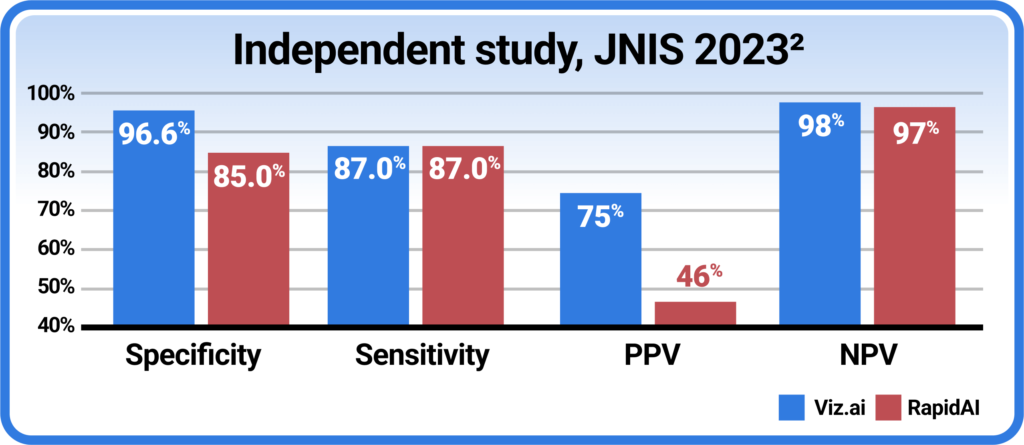Team Viz
Mar 13, 2025
In the fast-evolving field of AI-powered healthcare, hospitals need trusted solutions that deliver the best patient outcomes. That’s why more than 500 hospitals have made the switch to Viz.ai. Here are four key reasons why:
1. Proven Clinical Performance of Viz.ai
First, head-to-head, independent peer-reviewed clinical studies consistently demonstrate superior performance of Viz.ai.
An independent peer-reviewed FDA funded study, published in the Journal of American College of Radiology, showed better performance with Viz.ai, including higher detection rates and faster care team mobilization, ultimately leading to better patient outcomes. This study highlighted Viz.ai’s ability to identify critical conditions earlier, reducing the time between diagnosis and treatment — a crucial factor in stroke care.

Another independent peer-reviewed study, published in the Journal of NeuroInterventional Surgery found a difference in performance between the two algorithms. Viz.ai demonstrated 11% higher specificity and ~30% higher positive predictive value (PPV) than the competitor, emphasizing the significance of accuracy in stroke care. Researchers also experienced 3.4x more false positives using the competitor’s algorithm, which can lead to alarm desensitization, resulting in missed alarms and delayed responses that negatively impact patient outcomes.

A third peer-reviewed study (VISIION), published in the American Journal of Neuroradiology, assessed the impact of transitioning to the Viz.ai platform as part of a quality improvement initiative. The study highlighted significant improvements in workflow efficiency and quality of care following implementation. Researchers stated that, “there was an immediate improvement following Viz.ai implementation for both direct arriving and telemedicine transfer thrombectomy.” Specifically, the study found a 39% improvement in door-to-groin times for off-hours large-vessel occlusion (LVO) cases and a 30% decrease in messaging thread counts due to streamlined communication using the Viz.ai platform.
2. Ease of Use
90% of surveyed customers* who had switched to Viz.ai cited ease of use as one of the top reasons they prefer Viz.ai. Viz.ai has a simple, streamlined interface that allows healthcare professionals to quickly learn how to navigate the platform without extensive training. It presents essential information clearly, such as alerts, patient data, and imaging results, without overwhelming users.
- “The technology is available at your fingertips, making it easy for treatment planning and immediately mobilizing to ensure the fastest treatment for patients.” – IR Technologist
- “I love the quick images sent to my smartphone, with AI detection of cases from the spoke sites that I am not yet aware of, followed by seamless patient care coordination.” – Neurologist
3. Workflow Improvements
88% of surveyed customers highlighted Viz.ai’s positive impact on care coordination and team efficiency. Viz.ai has the strongest reputation for being able to seamlessly integrate into existing hospital workflows. Its AI-powered tools trigger automatic notifications and facilitate real-time collaboration, thus improving the overall stroke care process from detection to treatment.
- “Viz.ai brings together the whole team to expedite care.” – ED Physician
- “We have been using Viz.ai in our acute stroke workflow for more than a year, and it has made a HUGE difference in care coordination, time to endovascular lab, and enhanced communication across our neuroscience service lines. As an NP, using Viz.ai has also strengthened my ability to interpret CT and CTA.” – Nurse Practitioner
4. High-Quality Solutions
87% of respondents praised the quality of Viz.ai’s solutions, from imaging clarity to communication capabilities that keep care teams aligned.
- “The images are high quality, and the communication capabilities in the application really help team members talk with one another and develop a plan.” – Program Coordinator
Ready to Make the Switch?
Join the 500+ hospitals that have chosen Viz.ai to improve patient outcomes and streamline care coordination. Contact us here to learn more.
*Survey sample size was 168 respondents